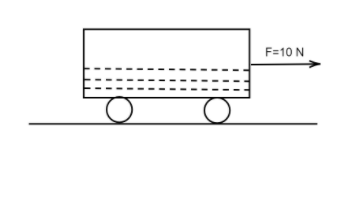
A cart has mass $2$ metric ton and sand $1$ metric ton is inside the cart. Now and start to leak with a rate of $0.5\text{ kg}\cdot {{\text{s}}^{-1}}$ then what is the velocity of cart when total sand comes out from the cart.


Answer
516.9k+ views
Hint: To solve this question, we can use the equation of acceleration written in terms of force and mass, but we also need to consider the rate of change of mass of the cart which in turn also makes the acceleration of the cart change with time. To find out the velocity we can use the relation that says that acceleration is the rate of change of velocity.
Complete step-by-step answer:
The acceleration of the cart if mass remains constant is the force applied to the cart divided by the mass of the cart. If written in the form of an equation, then it would be as follows:
$a=\dfrac{F}{m}$
If the mass of the cart is not constant, then acceleration will be as follows:
$a=\dfrac{F}{{{m}_{0}}-\mu t}$
Where, ${{m}_{0}}-\mu t$ is the mass of the cart at any time $t$ when the sand starts to leak.
Acceleration can also be written as:
$\dfrac{dv}{dt}=\dfrac{F}{{{m}_{0}}-\mu t}$
On re-arranging we get:
\[dv=\dfrac{Fdt}{{{m}_{0}}-\mu t}\]
On integrating both the sides we get the following:
\[\begin{align}
& \int\limits_{0}^{v}{dv}=F\int\limits_{0}^{t}{\dfrac{dt}{{{m}_{0}}-\mu t}} \\
& \Rightarrow v=\dfrac{F}{\mu }\ln \left( \dfrac{{{m}_{0}}}{{{m}_{0}}-\mu t} \right) \\
\end{align}\]
It is given that force $F=10\text{ N}$,
The initial mass of the cart is given as ${{m}_{0}}=2\text{ metric ton}$,
The rate of leakage of sand is given as \[\mu =0.5\text{ kg}\cdot {{\text{s}}^{-1}}\],
And the value of $\left( {{m}_{0}}-\mu t \right)=1\text{ metric ton}$, thus on substituting all the values, we get:
$\begin{align}
& v=\dfrac{10}{0.5}\ln \left( 2 \right) \\
& \Rightarrow v=20\times 0.693 \\
& \therefore v=13.86\text{ m}\cdot {{\text{s}}^{-1}} \\
\end{align}$
Therefore, the velocity of the cart when the total sand has come out of the cart will be $v=13.86\text{ m}\cdot {{\text{s}}^{-1}}$.
Note: We cannot apply the equation of static mechanics in this case because the mass of the cart does not remain constant, hence we need to consider the rate of change of mass of the whole cart when sand starts to leak from it and its mass keeps on decreasing constantly.
Complete step-by-step answer:
The acceleration of the cart if mass remains constant is the force applied to the cart divided by the mass of the cart. If written in the form of an equation, then it would be as follows:
$a=\dfrac{F}{m}$
If the mass of the cart is not constant, then acceleration will be as follows:
$a=\dfrac{F}{{{m}_{0}}-\mu t}$
Where, ${{m}_{0}}-\mu t$ is the mass of the cart at any time $t$ when the sand starts to leak.
Acceleration can also be written as:
$\dfrac{dv}{dt}=\dfrac{F}{{{m}_{0}}-\mu t}$
On re-arranging we get:
\[dv=\dfrac{Fdt}{{{m}_{0}}-\mu t}\]
On integrating both the sides we get the following:
\[\begin{align}
& \int\limits_{0}^{v}{dv}=F\int\limits_{0}^{t}{\dfrac{dt}{{{m}_{0}}-\mu t}} \\
& \Rightarrow v=\dfrac{F}{\mu }\ln \left( \dfrac{{{m}_{0}}}{{{m}_{0}}-\mu t} \right) \\
\end{align}\]
It is given that force $F=10\text{ N}$,
The initial mass of the cart is given as ${{m}_{0}}=2\text{ metric ton}$,
The rate of leakage of sand is given as \[\mu =0.5\text{ kg}\cdot {{\text{s}}^{-1}}\],
And the value of $\left( {{m}_{0}}-\mu t \right)=1\text{ metric ton}$, thus on substituting all the values, we get:
$\begin{align}
& v=\dfrac{10}{0.5}\ln \left( 2 \right) \\
& \Rightarrow v=20\times 0.693 \\
& \therefore v=13.86\text{ m}\cdot {{\text{s}}^{-1}} \\
\end{align}$
Therefore, the velocity of the cart when the total sand has come out of the cart will be $v=13.86\text{ m}\cdot {{\text{s}}^{-1}}$.
Note: We cannot apply the equation of static mechanics in this case because the mass of the cart does not remain constant, hence we need to consider the rate of change of mass of the whole cart when sand starts to leak from it and its mass keeps on decreasing constantly.
Recently Updated Pages
Master Class 12 Business Studies: Engaging Questions & Answers for Success

Master Class 12 Economics: Engaging Questions & Answers for Success

Master Class 12 English: Engaging Questions & Answers for Success

Master Class 12 Maths: Engaging Questions & Answers for Success

Master Class 12 Social Science: Engaging Questions & Answers for Success

Master Class 12 Chemistry: Engaging Questions & Answers for Success

Trending doubts
What is meant by exothermic and endothermic reactions class 11 chemistry CBSE

Which animal has three hearts class 11 biology CBSE

10 examples of friction in our daily life

One Metric ton is equal to kg A 10000 B 1000 C 100 class 11 physics CBSE

1 Quintal is equal to a 110 kg b 10 kg c 100kg d 1000 class 11 physics CBSE

Difference Between Prokaryotic Cells and Eukaryotic Cells




